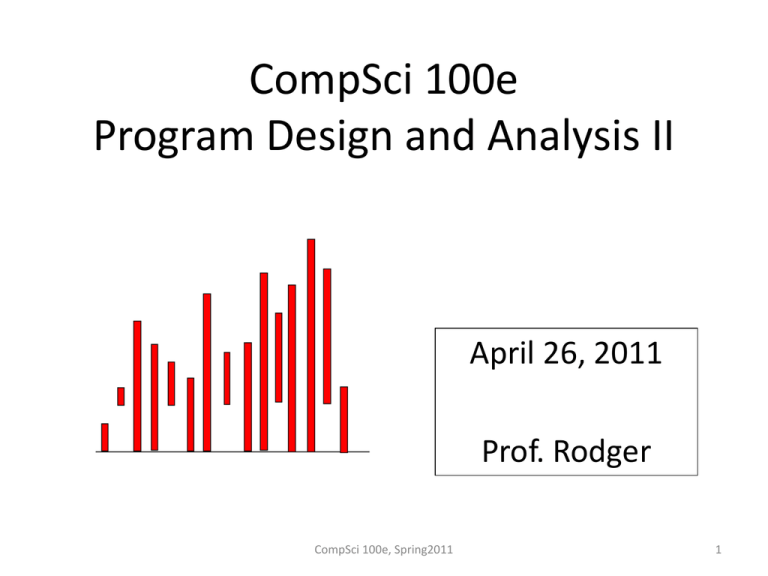CompSci 100e Program Design and Analysis II April 26, 2011 Prof. Rodger
advertisement

CompSci 100e
Program Design and Analysis II
April 26, 2011
Prof. Rodger
CompSci 100e, Spring2011
1
Announcements
• Things due this week:
– APTs due today, Apr 26
– Extra credit assignments due Wed, Apr 27
– No late assignments accepted after Wed night!
• Today
– Test 2 back – solutions posted on calendar page
– Balanced Trees
– Sorting
CompSci 100e, Spring2011
2
Final Exam
• Final Exam – Wed, May 4, 7-10pm
–
–
–
–
Same room, old Chem 116
Covers topics up through today
Closed book, closed notes
Can bring 4 sheets of paper with your name on it
• Study - practice writing code on paper
– From tests this semester, from old tests
– From classwork, labs, assignments, apts….
• Will have different office hours til exam
– will post on front page of CompSci 100e web page
– Subject to change, check before coming over
CompSci 100e, Spring2011
3
Sorting: From Theory to Practice
• Why study sorting?
– Example of algorithm analysis in a simple, useful
setting
– Lots of sorts
• Compare running times
• Compare number of swaps
• http://www.sorting-algorithms.com/
CompSci 100e, Spring2011
4
Sorting out sorts
• Simple, O(n2) sorts --- for sorting n elements
– Selection sort --- n2 comparisons, n swaps, easy to code
– Insertion sort --- n2 comparisons, n2 moves, stable, fast, can
finish early
– Bubble sort --- n2 everything, easiest to code, slowest, ugly
• Divide and conquer sorts: O(n log n) for n elements
– Quick sort: fast in practice, O(n2) worst case
– Merge sort: good worst case, great for linked lists, uses
extra storage for vectors/arrays
• Other sorts:
– Heap sort, basically priority queue sorting O(n log n)
– Radix sort: doesn’t compare keys, uses digits/characters
– Shell sort: quasi-insertion, fast in practice, non-recursive
CompSci 100e, Spring2011
5
Selection sort: summary
• Simple to code n2 sort: n2 comparisons, only n swaps
• Repeat: Find next min, put it in its place in sorted order
void selectSort(String[] a) {
int len = a.length;
for(int k=0; k < len; k++){
int mindex = getMinIndex(a,k,len);
swap(a,k,mindex);
n
}
k = 1 + 2 + … + n = n(n+1)/2 = O(n2)
S
}
k=1
• # comparisons
– Swaps?
– Invariant:
Sorted, won’t move
final position
CompSci 100e, Spring2011
?????
6
SelectionSort
• Start
starting 2nd pass
• Starting 3rd pass
starting 4th pass
CompSci 100e, Spring2011
7
Insertion Sort: summary
• Stable sort, O(n2), good on nearly sorted vectors
– Stable sorts maintain order of equal keys
– Good for sorting on two criteria: name, then age
void insertSort(String[] a){
int k, loc; String elt;
for(k=1; k < a.length; ++k) {
elt = a[k];
loc = k;
// shift until spot for elt is found
while (0 < loc && elt.compareTo(a[loc-1]) < 0) {
a[loc] = a[loc-1];
// shift right
loc=loc-1;
}
a[loc] = elt;
}
?????
Sorted relative to
}
each other
CompSci 100e, Spring2011
8
Insertion Sort
• Start
in 4th pass
• Several later passes
after more passes
CompSci 100e, Spring2011
9
Bubble sort: summary of a dog
• For completeness you should know about this sort
– Really, really slow (to run), really really fast (to code)
– Can code to recognize already sorted vector (see insertion)
• Not worth it for bubble sort, much slower than insertion
void bubbleSort(String[] a){
for(int j=a.length-1; j >= 0; j--) {
for(int k=0; k < j; k++) {
if (a[k] > a[k+1])
swap(a,k,k+1);
}
}
Sorted, in final
?????
}
position
• “bubble” elements down the vector/array
CompSci 100e, Spring2011
10
Bubble sort
• Start
starting 2nd pass
• Starting 3rd pass
starting 4th pass
CompSci 100e, Spring2011
11
Summary of simple sorts
• Selection sort has n swaps, good for “heavy” data
– moving objects with lots of state, e.g., …
• In C or C++ this is an issue
• In Java everything is a pointer/reference, so swapping is fast
since it's pointer assignment
• Insertion sort good on nearly sorted data, stable!
– Also foundation for Shell sort, very fast non-recursive
– More complicated to code, but relatively simple, and
fast
• Bubble sort is a travesty? But it's fast to code if
you know it!
– Can be parallelized, but on one machine don’t go
near it
CompSci 100e, Spring2011
12
Quicksort: fast in practice
• Invented in 1962 by C.A.R. Hoare, didn’t
understand recursion
– Worst case is O(n2), but avoidable in nearly all cases
– In 1997 Introsort published (Musser, introspective
sort)
• Like quicksort in practice, but recognizes when it will be bad and changes to
heapsort
void quick(String[], int left, int right){
if (left < right) {
int pivot = partition(a,left,right);
quick(a,left,pivot-1);
quick(a,pivot+1, right);
}
}
• Recurrence?
<= X
X
>X
pivot index
CompSci 100e, Spring2011
13
Partition code for quicksort
•
what we want
<= pivot
> pivot
right
left
pIndex
what we have
??????????????
right
left
int partition(String[] a,
int left, int right)
{
string pivot = a[left];
int k, pIndex = left;
for(k=left+1, k <= right; k++) {
if (a[k].compareTo(pivot) <= 0){
pIndex++;
swap(a,k,pIndex);
}
}
swap(a,left,pIndex);
}
•
invariant
<=
>
???
right
left
pIndex
k
Easy to develop partition
•
loop invariant:
– statement true each time loop test is
evaluated, used to verify correctness
of loop
Can swap into a[left] before loop
– Nearly sorted data still ok
Analysis of Quicksort
• Average case and worst case analysis
– Recurrence for worst case: T(n) =
– What about average?
• Reason informally:
– Two calls vector size n/2
– Four calls vector size n/4
– … How many calls? Work done on each call?
• Partition: median of three, then sort
– Avoid bad performance on nearly sorted data
CompSci 100e, Spring2011
15
Analysis of Quicksort
• Average case and worst case analysis
T(n-1) + T(1) + O(n)
– Recurrence for worst case: T(n) =
T(n) = 2T(n/2) + O(n)
– What about average?
• Reason informally:
– Two calls vector size n/2
– Four calls vector size n/4
– … How many calls? Work done on each call?
• Partition: median of three, then sort
– Avoid bad performance on nearly sorted data
CompSci 100e, Spring2011
16
Merge sort: worst case O(n log n)
• Divide and conquer --- recursive sort
– Divide list/vector into two halves
• Sort each half
• Merge sorted halves together
– What is complexity of merging two sorted lists?
– What is recurrence relation for merge sort as
described?
T(n) =
• Advantage of array over linked-list for merge sort?
– What about merging, advantage of linked list?
– Array requires auxiliary storage (or very fancy coding)
CompSci 100e, Spring2011
17
Merge sort: worst case O(n log n)
• Divide and conquer --- recursive sort
– Divide list/vector into two halves
• Sort each half
• Merge sorted halves together
– What is complexity of merging two sorted lists?
– What is recurrence relation for merge sort as
described?
T(n) = T(n) = 2T(n/2) + O(n)
• Advantage of array over linked-list for merge sort?
– What about merging, advantage of linked list?
– Array requires auxiliary storage (or very fancy coding)
CompSci 100e, Spring2011
18
Merge sort: lists or arrays or …
• Mergesort for arrays
void mergesort(String[] a, int left, int right){
if (left < right) {
int mid = (right+left)/2;
mergesort(a, left, mid);
mergesort(a, mid+1, right);
merge(a,left,mid,right);
}
}
• What’s different when linked lists used?
– Do differences affect complexity? Why?
• How does merge work?
CompSci 100e, Spring2011
19
Summary of O(n log n) sorts
• Quicksort straight-forward to code, very fast
– Worst case is very unlikely, but possible, therefore …
– But, if lots of elements are equal, performance will be bad
• One million integers from range 0 to 10,000
• How can we change partition to handle this?
• Merge sort is stable, it’s fast, good for linked
lists, harder to code?
– Worst case performance is O(n log n), compare quicksort
– Extra storage for array/vector
• Heapsort, good worst case, not stable,
coding?
– Basically heap-based priority queue in a vector
CompSci 100e, Spring2011
20
Other sorts
• Shellsort
– Divide and conquer approach then insertion sort kicks
in
– Named after?
• Timsort
–
–
–
–
Sort in python
Named after?
Derived from mergesort and insertionsort
Very fast on real world data, using far fewer than the
worst case of O(n log n)
CompSci 100e, Spring2011
21
ShellSort
• Start
starting 2nd pass
• Starting 3rd pass
starting 4th pass
CompSci 100e, Spring2011
22
Sorting in practice
• Rarely will you need to roll your own sort, but when
you do …
– What are key issues?
• If you use a library sort, you need to understand the
interface
– In C++ we have STL
• STL has sort, and stable_sort
– In C sort is complex to use because arrays are ugly
– In Java guarantees and worst-case are important
• Why won’t quicksort be used?
• Comparators allow sorting criteria to change
CompSci 100e, Spring2011
23
Non-comparison-based sorts
•
•
•
•
lower bound: W(n log n) for
comparison based sorts (like
searching lower bound)
bucket sort/radix sort are notcomparison based, faster
asymptotically and in practice
sort a vector of ints, all ints in the
range 1..100, how?
– (use extra storage)
radix: examine each digit of
numbers being sorted
– One-pass per digit
– Sort based on digit
23 34 56 25 44 73 42 26 10 16
0
1
2
3
4
5
6
7
8
9
7
8
9
10 42 23 73 34 44 25 56 26 16
0
1
2
3
4
5
6
10 16 23 25 26 34 42 44 56 73
Non-comparison-based sorts
•
•
•
•
lower bound: W(n log n) for
comparison based sorts (like
searching lower bound)
bucket sort/radix sort are notcomparison based, faster
asymptotically and in practice
sort a vector of ints, all ints in the
range 1..100, how?
– (use extra storage)
radix: examine each digit of
numbers being sorted
– One-pass per digit
– Sort based on digit
23 34 56 25 44 73 42 26 10 16
10
0
1
42
73
23
2
3
44
34 25
4
5
16
26
56
6
7
8
9
8
9
10 42 23 73 34 44 25 56 26 16
26
16 25
10 23
0
1
2
44
34 42
3
4
56
5
73
6
10 16 23 25 26 34 42 44 56 73
7


